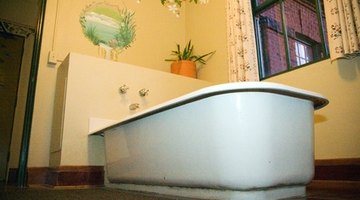What Type of Caulking Do You Use Around the Tub and Toilet Adjoining a New Vinyl Floor?
Caulking around the tub and toilet when you install new vinyl flooring is one of the most important steps you can take to protect the future of your floor. The last thing you want to find one evening is a floor full of water that has leaked from your tub or toilet and ruined the vinyl floor.
Latex Caulk

Although there are several different types of caulking, you should use latex caulk when working indoors. Latex caulk is extremely durable, lasting for up to 20 years without difficulty. It can be used to seal small gaps around the tub and toilet when you install vinyl flooring and will keep water from leaking out onto the floor. Latex caulk is typically white, off-white or clear but can be painted any color once it has dried.
The Purpose of Caulk
Caulk is a finishing material that is a combination between a sealant and an adhesive. It fills and seals cracks and gaps that allow air or water to move through them and adheres to the two surfaces on either side of the crack, such as the tub or toilet and your vinyl floor. One of the best attributes of latex caulk is that it allows both surfaces to move slightly while still keeping the crack filled and secure.
How to Apply Caulk
To apply latex caulk, insert the tube of caulk into your caulk gun, and cut the tip of the tube off at a 45-degree angle. Carefully push the tip of the tube into the crack at the base of the toilet or tub, and hold it at a 45-degree angle. Squeeze the trigger of the caulk gun and smoothly push the caulk tube along the crack. You want to push it away from you so the caulk will completely fill the crack. If you pull it back toward you, there may be a gap left where the caulk doesn't reach. Every few feet, stop and dip your finger into a dish of water and smooth the caulk out with your dampened finger.
Removing Old Caulk
Should you need to remove old caulk in the future, the first thing to do is pull up the strip of caulk to remove the bulk of it. You can use a heat gun or hairdryer set on hot to help soften the latex caulk to make it easier to remove. Simply blow the heat source across the caulk, moving it back and forth to avoid overheating it. Use a razor knife to scrape away any caulk that has not come up, and wash the area thoroughly with denatured alcohol. Once that is accomplished, your area is prepped for its next caulking.
References
Writer Bio
Marsanne Petty has been a writer and photographer for over ten years, and is currently pursuing the combination in tandem. She attended Madison Community College, receiving a degree in Administration. She has published several articles for magazines, including Jack Magazine, and the local newspaper, the Jasper News. Her latest creation, a pictoral history of Hamilton County, Florida, was published in early 2009 through Arcadia Publishing.
Photo Credits
- bathroom image by Mat Hayward from Fotolia.com
More Articles



